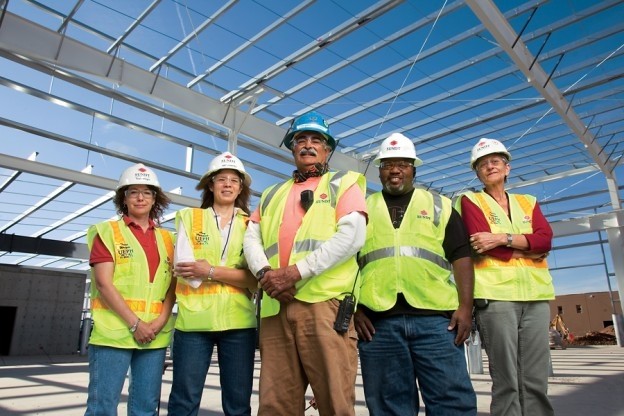Construction Safety Ideas

The construction industry is filled with potential sources of injury and even death for construction workers. This is because construction, by its very nature, requires physical activities, such as soldering, working from scaffolds, working with explosives, handling big machinery and equipment, working in confined spaces and working with chemicals. The National Institute for Occupational Safety and Health, or NIOSH, and the Occupational Safety and Health Administration, or OSHA, are two organizations that recommend standards for worker safety.
Working with Scaffolding
Practicing safety measures with scaffolding can save lives.
According to NIOSH, falls are a leading cause of traumatic occupational death. Records from National Traumatic Occupational Fatalities, or NTOF, a database of NIOSH, show that from 1980 to 1985, falls were responsible for almost 10 percent of all traumatic occupational deaths with identifiable causes. Deadly falls from scaffolds accounted for 17 percent of recorded falls from high working surfaces in the same period. Causes were due to the failure of scaffolding equipment, improper use of scaffolding equipment and negligence. To prevent such injuries and deaths, NIOSH recommends that workers and employers of those working with scaffolds should make sure that the design of scaffolds should conform with the requirements of OSHA in regard to construction equipment, rated capacities, equipment type and usage. Drop lines and suspension ropes for body belts or harnesses should be protected from corrosive substances, such as chemicals, sharp edges and heat. A competent person must inspect all the components of fall protection equipment before each use, and employers should provide proper training to their workers and ensure that they make use of proper fall protection systems.
Preventing Dust Exposure
Crystalline sylica inhalation can cause a repiratory illness.
Construction workers routinely perform duties that put them in danger of inhaling dust that contains crystalline silica. Crystalline sylica inhalation causes silicosis, a potentially fatal lung disease. It also leads to lung cancer and kidney disease. Crystalline silica can be in the form of quartz, cristobalite or tridymite. It can be stirred up during construction activities, such as the blasting of concrete; crushing, loading and dumping of rock; rock drilling; demolition of concrete structures and air blowing of rock, concrete or sand dust. To reduce the risks associated with dust inhalation, keep the number of workers in an area where dust will be raised to a minimum. Post conspicuous signs to warn workers about the dangers of dust inhalation. Change into disposable or washable work clothes when at the work site and shower and change before leaving the work site. Do not use an air blower to remove dust from clothes; use a vacuum instead. Wet the work area to reduce dust and use respiratory equipment as needed.
Preventing Lead Poisoning
Always check respiratory equipment to make sure it is functioning correctly.
Construction workers may be exposed to lead while working on bridges or other steel structures, such as water and fuel storage tanks. To avoid the lead poisoning, which may cause anemia, loss of appetite, cramps and vomiting, wear protective clothing and appropriate respiratory equipment.
Working with Scaffolding
Practicing safety measures with scaffolding can save lives.
According to NIOSH, falls are a leading cause of traumatic occupational death. Records from National Traumatic Occupational Fatalities, or NTOF, a database of NIOSH, show that from 1980 to 1985, falls were responsible for almost 10 percent of all traumatic occupational deaths with identifiable causes. Deadly falls from scaffolds accounted for 17 percent of recorded falls from high working surfaces in the same period. Causes were due to the failure of scaffolding equipment, improper use of scaffolding equipment and negligence. To prevent such injuries and deaths, NIOSH recommends that workers and employers of those working with scaffolds should make sure that the design of scaffolds should conform with the requirements of OSHA in regard to construction equipment, rated capacities, equipment type and usage. Drop lines and suspension ropes for body belts or harnesses should be protected from corrosive substances, such as chemicals, sharp edges and heat. A competent person must inspect all the components of fall protection equipment before each use, and employers should provide proper training to their workers and ensure that they make use of proper fall protection systems.
Preventing Dust Exposure
Crystalline sylica inhalation can cause a repiratory illness.
Construction workers routinely perform duties that put them in danger of inhaling dust that contains crystalline silica. Crystalline sylica inhalation causes silicosis, a potentially fatal lung disease. It also leads to lung cancer and kidney disease. Crystalline silica can be in the form of quartz, cristobalite or tridymite. It can be stirred up during construction activities, such as the blasting of concrete; crushing, loading and dumping of rock; rock drilling; demolition of concrete structures and air blowing of rock, concrete or sand dust. To reduce the risks associated with dust inhalation, keep the number of workers in an area where dust will be raised to a minimum. Post conspicuous signs to warn workers about the dangers of dust inhalation. Change into disposable or washable work clothes when at the work site and shower and change before leaving the work site. Do not use an air blower to remove dust from clothes; use a vacuum instead. Wet the work area to reduce dust and use respiratory equipment as needed.
Preventing Lead Poisoning
Always check respiratory equipment to make sure it is functioning correctly.
Construction workers may be exposed to lead while working on bridges or other steel structures, such as water and fuel storage tanks. To avoid the lead poisoning, which may cause anemia, loss of appetite, cramps and vomiting, wear protective clothing and appropriate respiratory equipment.
- f3d81f245f7071dff29fcaca32b0175b32.jpg